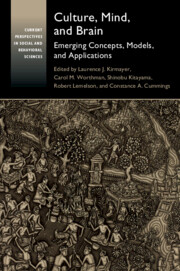47 results
Preface
-
- Book:
- Culture, Mind, and Brain
- Published online:
- 18 September 2020
- Print publication:
- 24 September 2020, pp xvii-xx
-
- Chapter
- Export citation
Abbreviations
-
- Book:
- Culture, Mind, and Brain
- Published online:
- 18 September 2020
- Print publication:
- 24 September 2020, pp xxi-xxiv
-
- Chapter
- Export citation
Epigraph
-
- Book:
- Culture, Mind, and Brain
- Published online:
- 18 September 2020
- Print publication:
- 24 September 2020, pp vi-vi
-
- Chapter
- Export citation
Part I - Dynamics of Culture, Mind, and Brain
-
- Book:
- Culture, Mind, and Brain
- Published online:
- 18 September 2020
- Print publication:
- 24 September 2020, pp 51-362
-
- Chapter
- Export citation
Figures
-
- Book:
- Culture, Mind, and Brain
- Published online:
- 18 September 2020
- Print publication:
- 24 September 2020, pp x-xi
-
- Chapter
- Export citation
Section 2 - The Situated Brain
- from Part I - Dynamics of Culture, Mind, and Brain
-
- Book:
- Culture, Mind, and Brain
- Published online:
- 18 September 2020
- Print publication:
- 24 September 2020, pp 159-272
-
- Chapter
- Export citation
Contributors
-
- Book:
- Culture, Mind, and Brain
- Published online:
- 18 September 2020
- Print publication:
- 24 September 2020, pp xiii-xvi
-
- Chapter
- Export citation
1 - Introduction
-
-
- Book:
- Culture, Mind, and Brain
- Published online:
- 18 September 2020
- Print publication:
- 24 September 2020, pp 1-50
-
- Chapter
- Export citation
Contents
-
- Book:
- Culture, Mind, and Brain
- Published online:
- 18 September 2020
- Print publication:
- 24 September 2020, pp vii-ix
-
- Chapter
- Export citation
22 - Epilogue
- from Part II - Applications
-
-
- Book:
- Culture, Mind, and Brain
- Published online:
- 18 September 2020
- Print publication:
- 24 September 2020, pp 494-512
-
- Chapter
- Export citation
Dedication
-
- Book:
- Culture, Mind, and Brain
- Published online:
- 18 September 2020
- Print publication:
- 24 September 2020, pp v-v
-
- Chapter
- Export citation
4 - Being There
- from Section 1 - The Co-emergence of Culture, Mind, and Brain
-
-
- Book:
- Culture, Mind, and Brain
- Published online:
- 18 September 2020
- Print publication:
- 24 September 2020, pp 120-158
-
- Chapter
- Export citation
Index
-
- Book:
- Culture, Mind, and Brain
- Published online:
- 18 September 2020
- Print publication:
- 24 September 2020, pp 513-534
-
- Chapter
- Export citation
Tables
-
- Book:
- Culture, Mind, and Brain
- Published online:
- 18 September 2020
- Print publication:
- 24 September 2020, pp xii-xii
-
- Chapter
- Export citation
Part II - Applications
-
- Book:
- Culture, Mind, and Brain
- Published online:
- 18 September 2020
- Print publication:
- 24 September 2020, pp 363-512
-
- Chapter
- Export citation
Section 3 - How Social Coordination and Cooperation are Achieved
- from Part I - Dynamics of Culture, Mind, and Brain
-
- Book:
- Culture, Mind, and Brain
- Published online:
- 18 September 2020
- Print publication:
- 24 September 2020, pp 273-276
-
- Chapter
- Export citation
Section 1 - The Co-emergence of Culture, Mind, and Brain
- from Part I - Dynamics of Culture, Mind, and Brain
-
- Book:
- Culture, Mind, and Brain
- Published online:
- 18 September 2020
- Print publication:
- 24 September 2020, pp 53-158
-
- Chapter
- Export citation
Copyright page
-
- Book:
- Culture, Mind, and Brain
- Published online:
- 18 September 2020
- Print publication:
- 24 September 2020, pp iv-iv
-
- Chapter
- Export citation

Culture, Mind, and Brain
- Emerging Concepts, Models, and Applications
-
- Published online:
- 18 September 2020
- Print publication:
- 24 September 2020
Interpersonal violence and suicidality among former child soldiers and war-exposed civilian children in Nepal
-
- Journal:
- Global Mental Health / Volume 5 / 2018
- Published online by Cambridge University Press:
- 22 February 2018, e9
-
- Article
-
- You have access
- Open access
- HTML
- Export citation



